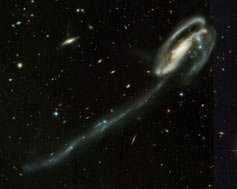
Handy Links
SLAC News Center
SLAC Today
- Subscribe
- Archives: Feb 2006-May 20, 2011
- Archives: May 23, 2011 and later
- Submit Feedback or Story Ideas
- About SLAC Today
SLAC News
Lab News
- Interactions
- Lightsources.org
- ILC NewsLine
- Int'l Science Grid This Week
- Fermilab Today
- Berkeley Lab News
- @brookhaven TODAY
- DOE Pulse
- CERN Courier
- DESY inForm
- US / LHC
SLAC Links
- Emergency
- Safety
- Policy Repository
- Site Entry Form

- Site Maps
- M & O Review
- Computing Status & Calendar
- SLAC Colloquium
- SLACspeak
- SLACspace
- SLAC Logo
- Café Menu
- Flea Market
- Web E-mail
- Marguerite Shuttle
- Discount Commuter Passes
-
Award Reporting Form
- SPIRES
- SciDoc
- Activity Groups
- Library
Stanford
Around the Bay
Exposing the Nature of Cosmic Liaisons
 Risa Wechsler of the Kavli Institute for Particle Astrophysics and Cosmology (KIPAC) and her collaborators have devised a powerful technique to study how interactions between galaxies affect star formation. Their results shed light on the fundamental processes that drive galactic evolution.
Risa Wechsler of the Kavli Institute for Particle Astrophysics and Cosmology (KIPAC) and her collaborators have devised a powerful technique to study how interactions between galaxies affect star formation. Their results shed light on the fundamental processes that drive galactic evolution.
In the early universe, the rate of star formation was higher than it is today. Galaxies frequently collided and coalesced with one another, spawning a profusion of new stars with each encounter. Although such prolific events are now relatively infrequent, less spectacular galactic interactions continue to forge stars and shape galaxies. Observational studies suggest that even these interactions increase the rate of star formation, but there is little consensus on the frequency and magnitude of such events.
"To study this, you need to observe pairs of galaxies, which have either just interacted or are about to interact, and determine whether their star formation rate is higher or lower than similar galaxies that haven't interacted," said Wechsler, who collaborated with researchers from the Center for Cosmology at the University of California in Irvine and the University of Chicago. Although the idea is straightforward, its execution is problematic. Galaxy interactions are highly complex and dynamic, and observation yields a mere snapshot of the unfolding events.
One complication is that the majority of galaxies exist in groups, where frequent interactions may have exhausted a galaxy's star-forming resources. In such crowded environments, it is difficult to discern the immediate effects of an isolated interaction. According to Wechsler, "it's very hard from observations alone to figure out how to control for this."
To overcome this technical hurdle, Wechsler used a cosmological simulation of dark matter and galaxies. “The simulation allowed us to see statistically how galaxies are connected to their environment. This enabled us to estimate the bias of pairs [toward group environments], and then to try to define selection criteria that would give us isolated pairs and appropriate controls." The criteria also controlled for galaxy age and brightness, thus optimizing their comparability.
Elizabeth Barton, Wechsler's collaborator from UCI, then used these criteria to analyze a subset of the 2dF astronomical survey. The analysis revealed that 14% of the galaxies in close pairs exhibited star formation rates boosted by at least a factor of 5, and on average a factor of 30. "This is the first clean estimate of triggered star formation from a large galaxy sample," Wechsler noted. "Our selection criteria allow us to constrain how the star formation rate changes in interactions, and will help us figure out how star formation contributes to galaxy evolution."
—Elizabeth Buchen, SLAC Today, October 15, 2007
Above image: Risa Wechsler has developed a new tool for measuring how galaxy interactions, such as that which drew out the trail of stars in the Tadpole Galaxy (pictured here), affect the rate of star formation.